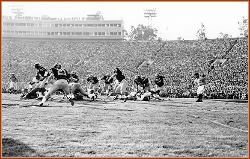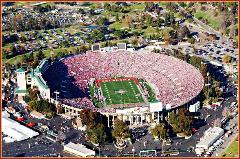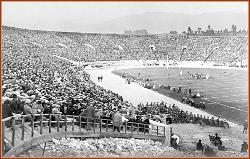Le Stade Olympique (The Olympic Stadium) is a stadium in Montreal, Quebec, Canada. Originally built to be the main venue of the 1976 Summer
Olympics, it was subsequently used mainly by Montreal's professional baseball and Canadian football teams. The stadium, now functioning as a
56,040-seat multipurpose facility, has been and continues to be used to host a wide variety of events such as trade shows, unique sporting
events, giant parties, and religious services.
It has the largest seating capacity of any stadium in Canada.
Ground Breaking of Olympic Stadium
The stadium was designed by French architect Roger Taillibert to be a
very elaborate facility featuring a retractable roof, which was to be opened
and closed by a huge 175-metre (583 ft 4 in) tower — the tallest inclined
structure in the world, six metres (20 ft) taller than the Washington
Monument, and the sixth tallest building in Montreal.
The Olympic swimming pool is located under this tower. An Olympic
velodrome (since converted to the Montreal Biodome, an indoor nature
museum) was situated at the base of the tower in a building similar in
design to the swimming pool. The building was built as the main stadium
for the 1976 Summer Olympic Games. The stadium was host to various
events including: the opening and closing ceremonies, athletics, football
finals, and some equestrian events.
Construction
As construction was well underway, a labour strike caused a major delay
to the building of the tower. The roof languished in a warehouse in France
until 1982.
(not-so) Grand Opening
Problems plagued the stadium from the time it opened for the Olympic
Games, when it was only half built.
Seating 58,500 at the time, the stadium was not fully completed in time for
the games due to strikes by construction workers, leaving it without a
tower or roof for the opening and several years following. Both the tower
and the roof, made of over 60,000 square feet (5,575 square metres) of
kevlar, were not completed for over a decade, and it was not until 1988
that it was possible to retract the roof. The 65-ton roof then proved
difficult to retract, and could not operate at all in winds greater than 25
mph. It was also torn during high winds.
Stadium Financing
Despite initial projections in 1970 that the stadium would cost only C$134 million to construct, strikes and construction delays served to escalate
these costs. By the time the stadium opened (in an unfinished form) the total costs had risen to C$264 million.
The Quebec government introduced a special tobacco tax in May 1976 to help recoup its investment. By 2006 the amount contributed to the
Olympic Installations Board accounted for 8% of the tax revenue earned from cigarette sales. The 1976 special tobacco tax act stipulated that
once the stadium was paid off, ownership of the facility would be returned back to the City of Montreal.
In December 2006 the stadium's costs were finally paid in full. The total expenditure (including repairs, renovations, construction, interest, and
inflation) amounted to C$1.61 billion. Despite initial plans to complete payment in October 2006, an indoor smoking ban introduced in May 2006
curtailed the revenue gathered by the tobacco tax.
Perceived by many to be a white elephant, the stadium has also been dubbed The Big Owe, Uh-O or The Big Mistake. In a speech announcing
that Montreal would host the Olympic Games, then-mayor of Montreal, Jean Drapeau, is remembered for saying, "The Olympics can no more
have a deficit than a man can have a baby." This now-famous quote is often parodied by residents
On-Going Issues
Due to claims of being a poor venue for baseball, the Olympic Stadium was remodeled in 1991, with 12,000 seats being removed for Expos
games.
On September 8 of that year, support beams snapped and caused a 55 ton concrete slab to fall on to an interior walkway. No one was injured,
but the Expos had to move their final 13 home games of that season to the other cities. For the 1992 season, it was decided to keep the roof on
at all times. The roof was removed in May 1998, making the stadium open-air for the 1998 season. Later in 1998, a $26 million opaque blue roof
was installed which does not open.
In January 1999, a 350 square metre portion of the roof collapsed, dumping ice and snow on workers that were setting up for the annual
Montreal Auto Show. This led to the auto show leaving Olympic Stadium for good. Repaired once again, the roof has continued to prove less
than reliable, as structural breaches have occurred during the winter months (due to snow and ice accumulation). The contractors,
manufacturers and engineers of the roof are now being sued for the roof failure.
The stadium is now closed for four months every winter as the fire marshal has concerns about the roof being unable to support snow loads. A
third replacement roof is being considered as of March 2006.
Historic Games at Olympic Stadium
- April 15 1977 - The Expos set a personal attendance record for a regular season game as 57, 592 fans attend the first game at Olympic Stadium. They were
defeated 7 to 2 by the Phillies. Greg Luzinski of the Phils and Ellis Valentine of the Spos hit homers in the second inning, the first homeruns at the Expos new
home.
- July 20, 1978 - Shorstop Chris Speier (hitting in the number eight slot) hits for the cycle at Olympic Stadium in Montreal in front of a crowd of 14,108. Speier is
the second in Expos history to hit for the cycle. Pitcher Woodie Fryman picks up the victory (again).
- May 10, 1981 - Charlie Lea pitched a no hitter against the San Francisco Giants, deafeting them 4-0 at Olympic Stadium. The last out was recorded by Andre
Dawson in center field. Lea would go on to shutout the Giants again a week later on four hits in San Fransico for good measure.
- October 11 1981 - Steve Rogers defeats Steve Carlton of the Phillies 3-0 in a pitchers duel to win the National League Division Series. Rogers drove in two of the
three Expos runs to boot singling home Larry Parrish and Chris Speier in the fifth inning. The Expos advance to play the Dodgers who defeated the Astros.
Rogers previously defeated Carlton in game one of the series as well.
- October 19, 1981 - Blue Monday. In the decisive Game 5 of their only National League Championship Series, the Expos were defeated at home, 2-1, by the Los
Angeles Dodgers. Tim Raines opened the bottom of the first with a double against Cy Young Award-winning rookie sensation Fernando Valenzuela and scored
on an Andre Dawson double play ball. Valenzuela held the Expos scoreless the rest of the way, however, and the Dodgers tied the game at 1 in the top of the fifth
with two hits, a wild pitch and an RBI ground out off Expo starter Ray Burris. The teams remained tied until the top of the ninth, when Expo manager Jim Fanning
made a risky decision to relieve Burris with Game 3 winner Steve Rogers. Struggling closer Jeff Reardon was throwing alongside Rogers in the bullpen at the
time, but Fanning elected to summon his ace. Rogers retired Steve Garvey and Ron Cey in order, but outfielder Rick Monday homered to put Los Angeles ahead,
2-1, and crush the Expos' hopes of advancing to the World Series. Two-out walks from Gary Carter and Larry Parrish were all that the Expos could muster in the
9th, as Bob Welch preserved the one-run Dodger victory. The Expos lost the NLCS, 3-2, and never returned to the postseason.
- July 13, 1982 - The All-Star Game moved across the border and was played in Montreal's Olympic Stadium. It was the first Midsummer Classic ever to be held
outside of the United States. The National League won 4–1 before a crowd of 59 057. Steve Rogers was the winning pitcher and Dennis Eckersley took the loss.
Dave Concepción was named MVP. Five players represented the Expos on the National League squad: Gary Carter, Andre Dawson, Tim Raines, Al Oliver and
Rogers.
- August 16 1987 - Timmy Raines hits for the cycle in a 10-7 victory over the Pirates of Pittsburgh going five-for-five in the process at Olympic Stadium. A crowd of
26,134 were on hand to see it in Montreal.
- August 3 1989 - The Expos and Dodgers engage in a 22 inning marathon, the longest game in Expos history. It eventually ended when Rick Dempsey homered for
the Dodgers in the top half of the 22nd innings off Dennis Martinez in a very rare relief preformance. Rex Hudler would be caught stealing second in the bottom
half of the 22nd to end the game. The game would have ended earlier when an Expo scored from third on a sacrifice fly. The Dodger's appeal, that the runner left
the base too soon, was recognized by the third base umpire and the third out was recorded. The game also marked the first time a mascot was ejected by an
umpire. Youppi! dressed in a nightgown and nightcap pretended to go to sleep on top of the Dodgers dugout, former Montreal Royals reliever and then coach of
the Dodgers Tommy Lasorda demanded that Youppi! be run from the game. In the end the game took over 6 hours to finish and ended close to 2:00 am.
- September 17, 1993 - One of the most exciting pennant races in team history begins, as the Expos (85 wins, 62 losses, and 1 tie) play their final series against
their division rival Phillies (89 wins, 58 losses). The Expos rally back to take a 8 to 7 victory in front of 45,757 hometown fans at Montreal's Olympic Stadium. The
clutch hitting hero was a hearing disabled rookie named Curtis Pride who in his first major league at-bat doubled home two runners and scored on the following
play. After the game Pride said he couldn't hear the ovation but he could feel the vibration of the 45,757 Expos fans. The Expos would finish the season 94-68 but
unfortunately three games out of first place.
- June 3, 1995 - Pedro Martínez pitched 9 perfect innings against the San Diego Padres before giving up a hit in the 10th to notorious Expo-Killer Bip Roberts over
the head of Tony Tarasco in center field. He became the second pitcher in history, after Harvey Haddix, to have a perfect game broken up in extra innings.
- August 26, 2003 - The Expos rallied from twice large deficit to claim a 14-10 win against the Philadelphia Phillies and put in within two games of the National
League Wild Card. It was the second biggest comeback in Expos history.
- September 29, 2004 - Hours after the announcement of the impending move to Washington DC, the Expos played their final game in Montreal, a 9–1 loss to the
Florida Marlins before 31,395 fans at Olympic Stadium.













